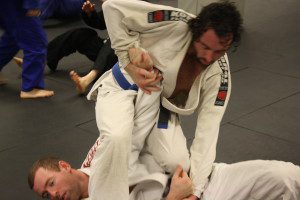By Jeff Patterson 6/18/09
In the early 1900’s Esai maeda, a jiu jitsu instructor from Japan, went to Brazil. After arriving in Brazil Esai met Gastao Gracie who was a very well known prominent business man.
 Gastao helped the Japanese immigrate to Brazil and helped them find work and residence. Esai was very grateful and offered to teach Carlos Gracie, Gastao’s oldest son,traditional Japanese jiu jitsu techniques. Carlos eventually started his own Jiu jitsu school, teaching all his brothers this Japanese style of jiu jitsu techniques. Helio Gracie, Gastaos’s youngest son was the smallest, slowest and the weakest of all his brothers. He had asthma, and had a difficult time pushing himself physically or doing any strenuous activities. He studied with Carlos, learning Jiu jitsu techniques and eventually becoming an instructor at his school. Because of Helio’s weakness he found some of the traditional Jiu jitsu techniques difficult to perform. With his intense determination he began looking for Jiu jitsu techniques that could be performed without as much force and learning to use more leverage to move an opponent. This was the beginning of Brazilian jiu jitsu.
Gastao helped the Japanese immigrate to Brazil and helped them find work and residence. Esai was very grateful and offered to teach Carlos Gracie, Gastao’s oldest son,traditional Japanese jiu jitsu techniques. Carlos eventually started his own Jiu jitsu school, teaching all his brothers this Japanese style of jiu jitsu techniques. Helio Gracie, Gastaos’s youngest son was the smallest, slowest and the weakest of all his brothers. He had asthma, and had a difficult time pushing himself physically or doing any strenuous activities. He studied with Carlos, learning Jiu jitsu techniques and eventually becoming an instructor at his school. Because of Helio’s weakness he found some of the traditional Jiu jitsu techniques difficult to perform. With his intense determination he began looking for Jiu jitsu techniques that could be performed without as much force and learning to use more leverage to move an opponent. This was the beginning of Brazilian jiu jitsu.
If you have the desire to study Brazilian jiu jitsu techniques you will need to understand the concept of sticking, as well as learning how to go with your opponents force rather than trying to overpower him into submission. All of the jiu jitsu techniques you will learn depend on you executing them with correct form and technique rather than speed or strength. This does not mean speed and strength will not help you. I have heard over and over again through my martial arts career that conditioning is 75% of the fight. The idea is to use a technique to move your opponent with the least amount of force to accomplish your goal. This will conserve your energy and help you to stay more focused. When looking at two well conditioned athletes the one who understands these principles of how to utilize proper technique will win. Using your mind to stay ahead of your opponent keeping him in an inferior position will make it difficult for him to use his strength. In the beginning there are jiu jitsu techniques that you will learn in a step by step procedure. At each step along the way you will learn other variables and transitional moves that will expand your ability to stay ahead of your training partner. Every move is compiled from several smaller, or transitional moves that you will need to perform in a specific sequence in order to be successful and complete the submission, sweep or escape.
In the next section I will discuss a few jiu jitsu technique tips that hopefully will help your game.
Arm Bar- A jiu jitsu technique that can be used from many angles and most positions, very important part of any jiu jitsu player’s game. Instead of solely focusing on the arm and trying to lock it immediately, think about your control of the position squeeze the thighs, keep opponent pinned to the ground then with a good hold to the arm extend your hips to lock out the arm.
Triangle Choke- Once you are in position with the choke squeeze your knees together, pull opponents head down, lift your hips and kick your free foot out to the side. This will tighten the hold and make your opponent go to sleep unless he taps out.
Maintaining the Guard- One of the most common mistakes I see with new jiu jitsu players is when they get someone in their guard, they lock their feet and just hold on. This does give you a basic control, but to develop a good guard you should experiment with a variety of guard positions full guard, open guard, ½ guard, butterfly guard, ½ butterfly guard, rubber guard, spider guard, etc… This will make your guard more difficult to pass as well as give you opportunities for sweeps and submissions.
Read on about Jiu Jitsu training and Strategy



